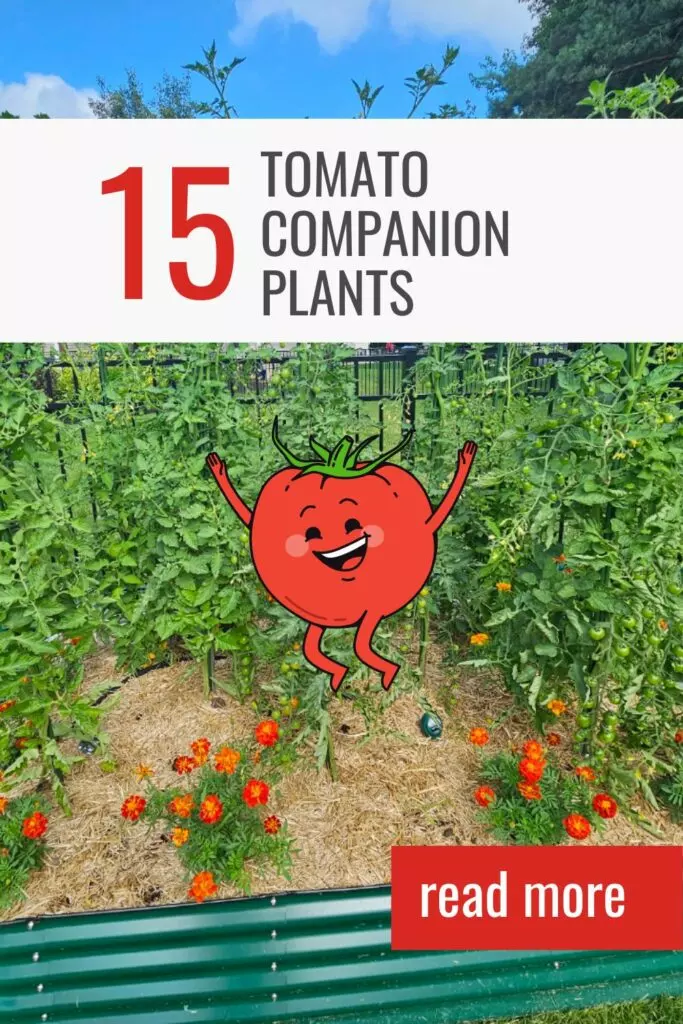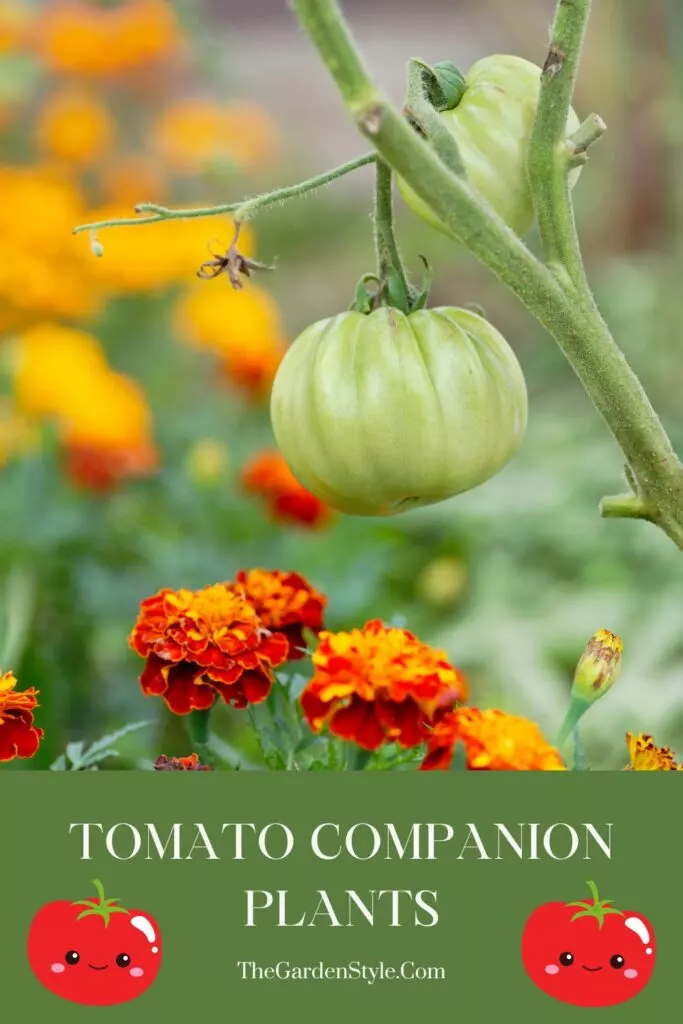Have you ever wondered if certain plants grow better next to tomatoes? As a beginner gardener, learning about tomato companion planting can help you boost your tomato harvest and overall garden health. Tomato companion plants are plants that are strategically planted next to tomatoes to help each other grow better. Let’s explore the basics of companion planting, the best tomato companion plants, techniques for success, and common mistakes to avoid with tomato companion planting.
Table of Contents
What Are Companion Plants?
Companion planting is the practice of planting different crops together so they can benefit each other. It’s based on the idea that certain plants can positively influence others when planted in close proximity. Companion planting creates mutually beneficial relationships between vegetables, fruits, herbs, and flowers. By strategically placing companion plants close together, they are able to protect and support each other in various ways.
How Does Companion Planting Work?
Plants can help each other in a variety of ways:
- Deter pests – Some plants repel or mask the scent of other plants, driving away insects.
- Attract pollinators – Flowers interplanted with crops draw in pollinating bees.
- Enhance flavor – Some combinations actually make fruits and veggies taste better.
- Improve growth – Certain plants help nourish the soil with nutrients that neighboring plants need.
- Maximize space – Pairing low-growing plants with taller vegetables makes efficient use of the garden.
- Prevent disease – Crop rotation and diversity keep soil healthy and ward off disease.
Benefits of Companion Planting
Companion planting offers many benefits:
- Reduces the need for pesticides and fertilizers
- Boosts pollination
- Maximizes garden space
- Controls pests naturally
- Improves flavor and nutrition
- Increases crop yields
- Enriches soil health and biodiversity
Best Companion Plants for Tomatoes
Now that we’ve covered the basics of companion planting, let’s dive into some of the top companion plants that pair exceptionally well with tomato plants. Selecting the right tomato companion plants can help deter pests, attract pollinators, improve flavor, enrich the soil, and boost yields. While tomatoes go well with many different plants, some of the best include herbs like basil, flowers like marigolds, and vegetables like carrots and peppers. Keep reading to learn more about ideal tomato companion plants and how they benefit your tomatoes.
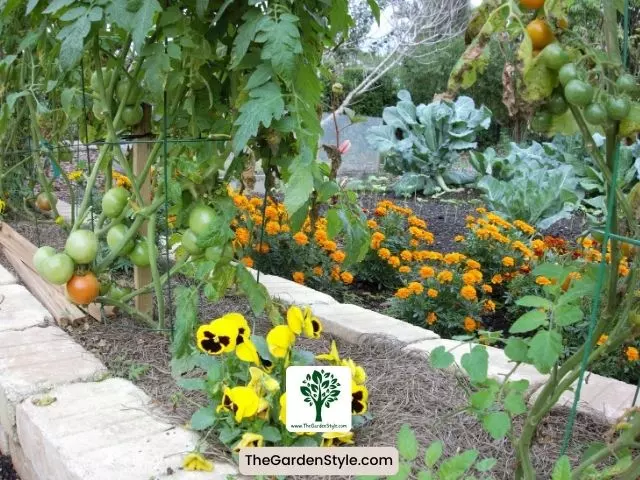
Herbs as Tomato Companion Plants
Herbs make ideal tomato companion plants. Many aromatic herbs contain strong scents that help confuse and repel common tomato pests like aphids, flies, and beetles. When interplanted with tomatoes, herb companions also provide numerous benefits beyond pest deterrence. Their flavorsome oils can actually enhance the taste of tomato fruits growing nearby. Plus, herb companions like basil and parsley add visual appeal and additional harvest options. Growing herbs along with your tomatoes can help boost your garden’s health and productivity.
Basil
This classic combo is made in heaven – basil deters flies, mosquitoes, and aphids while improving tomato growth and taste. Plus, both thrive in warm weather and need similar care. So, it is a great idea to plant basil liberally throughout the tomato garden bed. Learn more about how to plant basil.
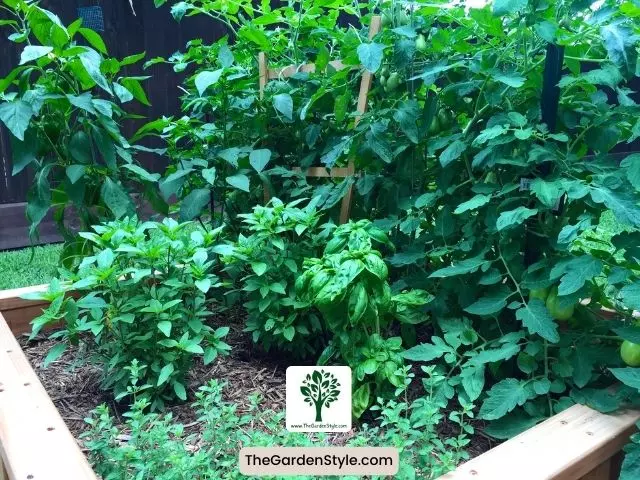
Thyme
Thyme is another excellent herb companion for tomatoes. Like other aromatic herbs, thyme contains oils that confuse pests and help mask the scent of tomato plants. This makes tomatoes less appealing to certain insects. Learn more about how to grow thyme from seeds.
Parsley
Parsley enhances overall garden health by attracting predatory insects that prey on tomato pests. It also improves flavor and provides an edible ground cover.
Chives
Onions and garlic are known to repel aphids, spider mites, and cabbage loopers. Chives offer a more compact option, so plant clusters near tomatoes. Check out my latest post on planting chives for some easy-to-follow tips.
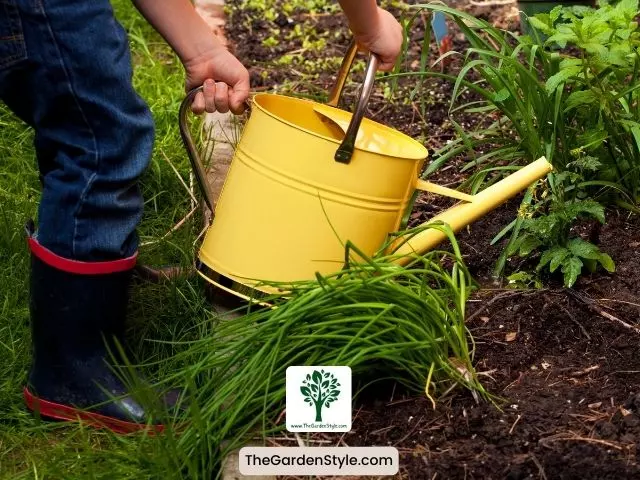
Cilantro
Cilantro makes an excellent herb companion for tomatoes. Its strong scent helps repel spider mites, which can be a problematic pest for tomatoes. The ferny, delicate foliage of cilantro also looks beautiful, contrasted with the larger tomato plant leaves. Check out my latest post on growing cilantro in water.
Flowering Tomato Companion Plants
In addition to herbs, certain brightly colored flowers make excellent tomato companion plants. Flowers interplanted with tomatoes provide visual beauty and also serve as functional companions. Flowers like marigolds, petunias, and nasturtiums attract beneficial pollinators with their brightly colored blooms. Bees, butterflies, and other pollinating insects are drawn to the flowers and will help pollinate tomato plants while visiting the garden. Flowers can also attract predatory and parasitic insects that prey on common tomato pests. Using flowers as companion plants allows you to add visual appeal while also increasing pollination and natural pest control.
Marigolds
A garden favorite, marigolds repel nematodes and other pests with their roots. Plant them liberally around the garden and among tomatoes. Choose pungent French or African marigolds over milder American types. If you’re new to growing marigolds, check out our post on how to grow marigolds – a beginner’s guide to growing these cheery companion plants.
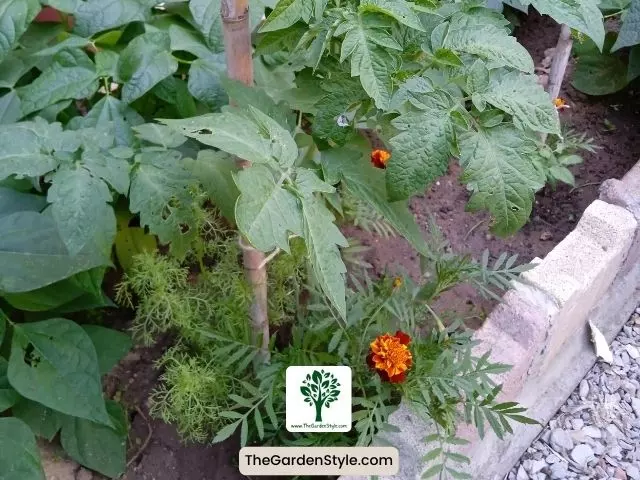
Petunias
Petunias are another pretty pest deterrent, driving away aphids, tomato hornworms, asparagus beetles, leafhoppers, and more. They also provide a pop of color wherever they grow.
Nasturtiums
With their trailing vines and edible flowers, nasturtiums are great for planting at the base of tomato plants. They deter aphids and other pests while attracting pollinators.
Zinnias
Zinnias are an excellent flowering companion for tomatoes. These plants attract pollinating bees, butterflies, and other beneficial insects to the garden with their colorful blooms. Different zinnia varieties come in heights ranging from 6 inches to 3 feet tall. Choose shorter varieties like ‘Profusion’ to tuck between tomatoes. Taller zinnias can serve as a background border. For tips on growing zinnias from seed, see Julia Morgan’s gardening guide on how to plant zinnias for a vibrant summer flower garden.
Calendula
Also called pot marigold, calendula is a handy flowering companion for tomatoes. The bright yellow and orange blooms attract a diversity of pollinating insects. These beneficial bugs aid in tomato pollination and fruit production. Calendula is also edible. Fresh and dried flowers are often used in summer salad recipes.
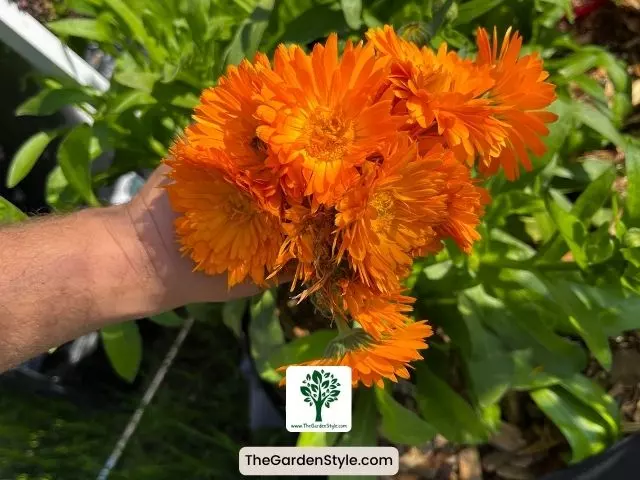
Vegetable Companion Plants for Tomatoes
Along with herbs and flowers, other vegetable plants can also make ideal companions for tomatoes. Certain vegetables are a natural fit when planted alongside tomatoes in the garden bed. For example, carrots and peppers are both excellent tomato companion plants. Carrots thrive when planted near tomatoes because their shallow roots don’t compete for nutrients while still benefitting the overall soil structure. Peppers are another great choice since they are from the same plant family as tomatoes and have similar growth habits and requirements. Interplanting compatible vegetable companions like carrots and peppers maximizes garden space while improving crop yields.
Carrots
Carrots and tomatoes make ideal garden bed partners. Some studies show carrots may even enhance tomato flavor! Carrots don’t take up much space, and their shallow roots won’t compete for nutrients.
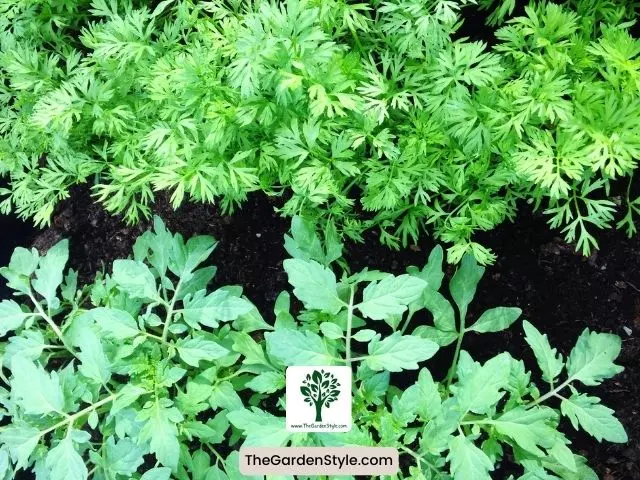
Peppers
Since tomatoes and peppers belong to the same plant family, they make an excellent match. Pairing them can confuse potential pests. Therefore, you should plant side by side or alternate rows. Learn more about how to grow peppers.
Asparagus
Asparagus makes a great larger backdrop for tomatoes, providing the perfect trellis. The ferny asparagus foliage repels certain flying pests.
Radishes
Radishes make a great vegetable companion for tomatoes in the garden. They grow quickly, and their fast-growing roots help break up and aerate the soil. The spicy radish roots also serve as a trap crop, luring pests like flea beetles away from tomatoes. See my guide on how to grow radish as an easy companion plant in the tomato patch.
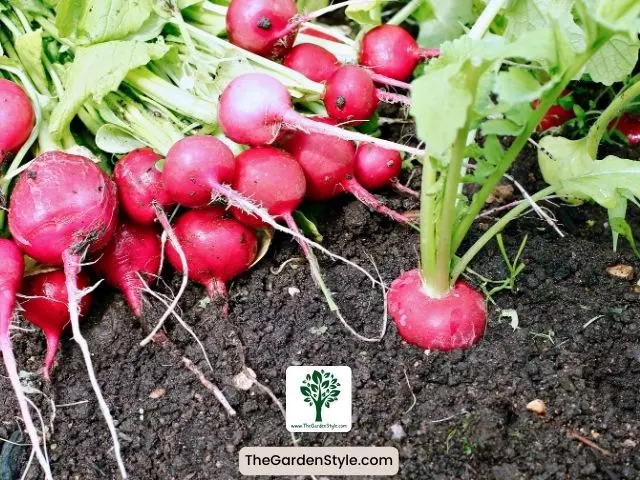
Cucumbers
Cucumbers pair nicely with tomatoes as companion plants. Both benefit from trellising, so they make good use of vertical growing space when supported together. Cucumbers have large leaves that provide shade for tomato plants. This can help prevent sun scalding on tomatoes in very hot climates.
However, since cucumbers and tomatoes can be susceptible to similar disease issues, don’t plant them in the same spot year after year. Rotate planting locations annually. With proper rotation, cucumbers and tomatoes thrive as companions. Learn how to grow cucumbers.
Companion Plants for Tomatoes Chart
| Companion Plants | Benefits for Tomatoes |
|---|---|
| Basil | Enhances flavor and repels pests |
| Thyme | Attracts beneficial insects and improves flavor |
| Parsley | Attracts predatory insects and improves flavor |
| Chives | Repels pests and improves flavor |
| Cilantro | Attracts beneficial insects and improves flavor |
| Marigolds | Repels nematodes and other pests |
| Petunias | Deters certain pests and adds color |
| Nasturtiums | Repels aphids and attracts predatory insects |
| Zinnias | Attracts pollinators and adds color |
| Calendula | Deters pests and promotes healthy growth |
| Carrots | Breaks up soil and provides ground cover |
| Peppers | Deter some pests and improve flavor |
| Asparagus | Acts as a natural pest deterrent |
| Radishes | Deter certain pests and improve soil structure |
| Cucumbers | Improve flavor and repel pests |
Companion Planting Techniques
To get the most out of companion planting, use these simple techniques:
Spacing and Layout
- Leave adequate space for growth when planting. Refer to seed packets for guidelines.
- Place tall plants like tomatoes, peppers, and asparagus at the back or north side of beds.
- Group companion plants close together for best interaction.
- Plant in squares or patches rather than rows to maximize diversity.
- Use trellises, cages, and stakes to boost vertical growing space.
Timing of Planting
- Stagger planting over 2-3 weeks for continuous harvest.
- Start companions like marigolds from seed indoors. Transplant into garden after the last frost.
- Direct sow carrots, parsley, and other quick-growing companions after soil warms.
- Water new seedlings daily until established. Use mulch to retain moisture.
Ongoing Maintenance
- Weed weekly to prevent competition. Weeds steal water and nutrients.
- Apply organic fertilizer or compost mid-season if plants need a nutrient boost.
- Prune overgrown plants to improve air circulation and reduce disease risk.
- Rotate annual companion plants to different beds each year.
Following these simple tips will lead to a healthy, thriving, companion-planted garden!
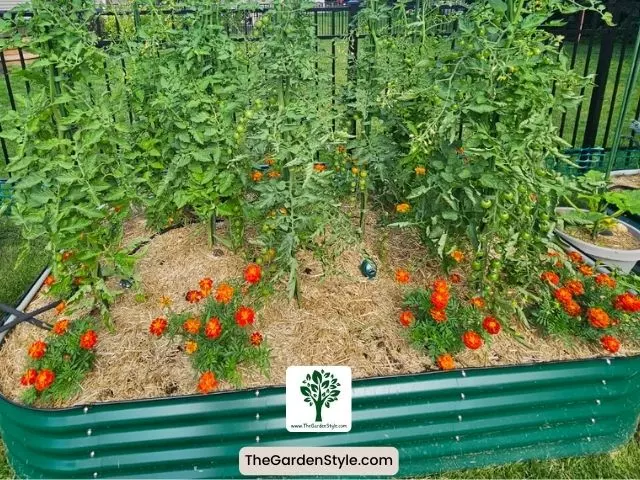
Avoiding Poor Companion Plants
When companion planting, it’s also essential to avoid poor pairings that don’t thrive:
- Keep cabbage family plants away from tomatoes, which they stunt.
- Avoid planting near fennel, which inhibits tomato growth.
- Never combine tomatoes and potatoes, which can both get blight.
With a bit of planning, you can orchestrate plant-pairing perfection and reap the tasty rewards!
Conclusion
Companion planting is an organic, chemical-free way to create an abundant harvest. By partnering tomatoes with compatible friends like basil, marigolds, peppers, and carrots, you can fill your garden with beauty and bounty. Optimizing these beneficial plant relationships results in better taste, improved health, larger yields, and natural pest control. Give companion planting a try this season for your tastiest tomatoes ever!
Frequently Asked Questions
Most companion plants should be grouped within 1-3 feet of each other or the plant they are supporting. Refer to spacing guidelines on seed packets.
Absolutely! Select compact, small varieties that suit containers. Make sure to use pots large enough for mature plant sizes.
Companion planting benefits all kinds of vegetables, fruits, and herbs. There are specific pairings that work well for carrots, broccoli, squash, beans, and more.
Save these pins for later so you can use this gardening guide on tomato companion plants.
